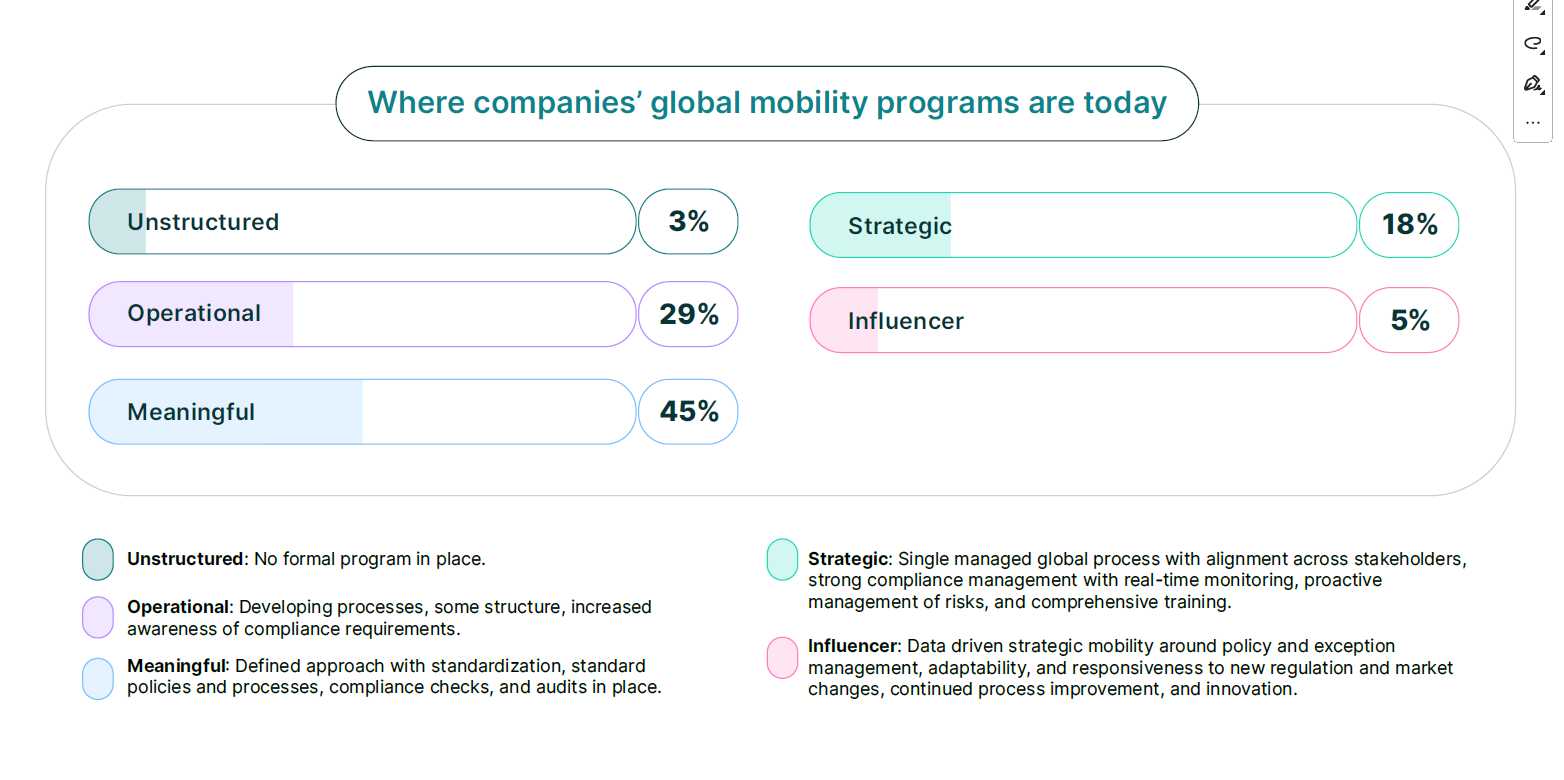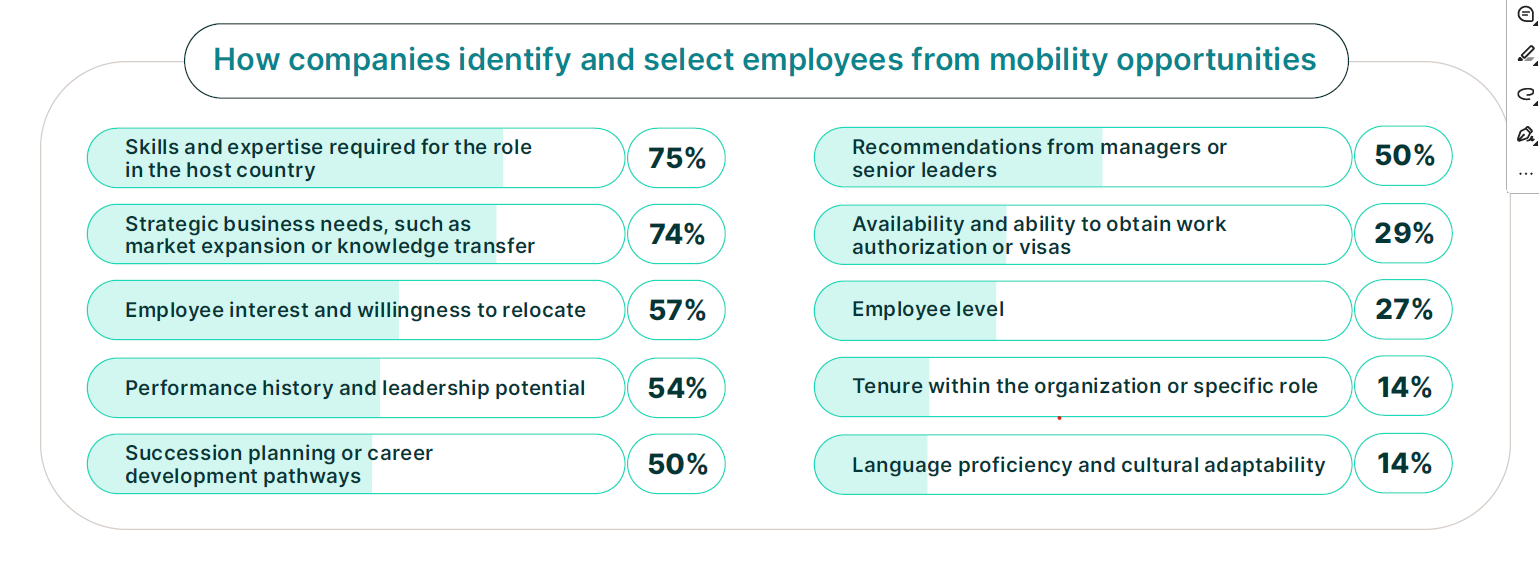share on
As HR evolves into a strategic talent enabler, mobility teams are rethinking their approach — aligning mobility with talent, reviewing policies, benchmarking benefits, and clarifying programme roles and responsibilities — to stay ahead in a fast-changing landscape.
Amidst talent shortages, geopolitical upheaval, legislative change, and growing demands for agility, businesses are under immense pressure to stay on the ball; all while delivering on experience, compliance, and cost.
But the reality is, most have overlooked the one function that is uniquely positioned to help them do just that: global mobility.
As mobility evolves from relocation logistics to strategic talent enabler, how are organisations adapting? A recent 2025 global mobility market survey by Vialto Partners revealed that 23% of respondents reach towards “Strategic” or “Influencer” level, where mobility is integrated into business priorities and proactive in managing risk.
The report, titled 'Mobility Matters survey: Key insights into mobility policies and practices', offers insights based on responses from 233 organisations across 35 countries and nine industries spanning the Americas, Europe, Asia-Pacific, the Middle East, and Africa. In this article, we will focus on the results revealed in the APAC region.
Programme maturity and strategic positioning
- Strategic/Influencer programmes are limited (15% Strategic, with none as Influencer)
- Operational/Unstructured programmes account for nearly half of programmes (44%)
- Meaningful (41%), but few operate at the highest maturity levels

APAC's top priorities for the year ahead
- Enhance the overall employee experience (37%)
- Align mobility with talent (33%)
- Review policies and/or benchmark policy support/benefits (33%)
- Define roles and responsibilities of programme (33%)
Top mobility challenges in the region
- Governance (roles and responsibilities): 41%
- Management of overall global mobility costs: 37%
- Compliance: 37%
Measurement of mobility outcomes
- Over a third of teams do not track and measure the success of their mobility programmes (42%) or career progression following a mobility opportunity (62%)
- Data gaps limit visibility into programme value and outcomes
Team size and delivery model
- Most teams are lean: 67% have 1-5 full-time employees and 10% have less than one FTE (i.e., not a full-time role)
- No respondents report having more than 20 FTEs
- This reflects compact delivery models, raising capacity questions as expectations grow
Other key themes that the report covered from a global remit include:
- Mobility teams continue the evolution from execution to strategic impact, not influence
According to the survey, nearly half of organisations (45%) describe their mobility programme as “Meaningful”, with defined processes, standardised policies, and a solid compliance foundation. However, only 23% report reaching the “Strategic” or “Influencer” level, where mobility is aligned with business priorities and proactive on risk.
Meanwhile, 32% remain in the “Unstructured” or “Operational” categories, which signals a persistent tail of reactive programmes.

While many mobility teams aim to evolve strategically, operational demands continue to weigh them down. Compliance (49%) and cost management (36%) remain top challenges — highlighting the need for greater operational support beyond the mobility function.
Strategic enablers such as executive sponsorship and leadership engagement rank much lower, suggesting a gap in top-level backing.
Still, mobility leaders are looking ahead. Many are turning to AI and automation to boost efficiency, ensure compliance, and improve the employee experience.
The top three priorities for the next 12 months are:
- Aligning mobility with talent (34%)
- Enhancing employee experience (32%)
- Introducing new tools and innovations (32%)
Tax and immigration compliance (33%) also remains a key focus.
These trends signal a clear shift — mobility is being repositioned as a strategic driver of employee engagement, retention, and business growth.
- Unlocking mobility’s data potential: Building the infrastructure to match ambition
While many mobility teams are pursuing strategic goals, few are equipped with the data infrastructure to support them. Over 40% of organisations (44%) don’t track core success metrics, from employee satisfaction to stakeholder alignment.

The gap in tracking career progression post-mobility is striking — 76% of companies don’t track what happens after an assignment.
Among those that do, the outcomes are largely positive:
- 13% report employees are promoted within 1-2 years
- 6% say employees stay at the same level
- Only 3% report attrition
Technology could help, but adoption is still limited. Some companies are exploring AI and automation to:
- Estimate assignment costs
- Capture interdepartmental communication
- Integrate mobility with HRIS systems
However, responses suggest these are isolated experiments, not widespread or strategic transformations. Few organisations reported enterprise-level innovation or advanced analytics in mobility.
- Communication and selection are getting smarter: Mobility is aligning with talent
While mobility programmes still face structural and data-related hurdles, there are encouraging signs when it comes to how opportunities are communicated and how employees are selected.
When it comes to communication, companies are shifting away from traditional “broadcast” methods. Just 11% rely on company-wide announcements, and only 8% use HR emails or newsletters.
Instead, more targeted, talent-focused approaches are gaining ground.
- 39% of organisations send personal invitations to high-potential employees
- 38% integrate mobility into talent management or career development programmes


Photos / 2025 Vialto global mobility market survey
share on


